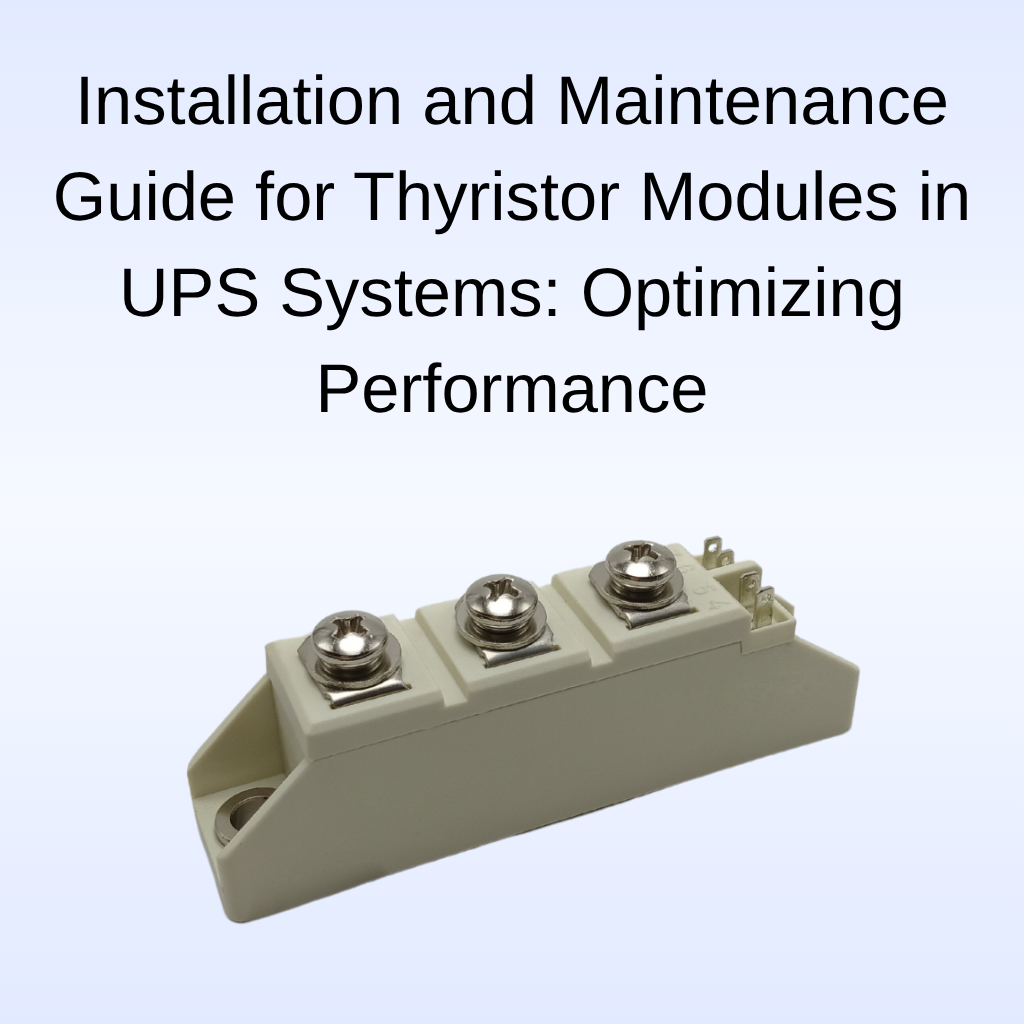Installation and Maintenance Guide for Thyristor Modules in UPS Systems: Optimizing Performance
Thyristor modules are vital components in Uninterruptible Power Supply (UPS) systems. These modules provide controlled power flow, enabling the UPS system to provide uninterrupted power to critical equipment during power outages or fluctuations. To ensure the reliability and efficiency of thyristor modules in UPS systems, proper installation and maintenance are crucial. This guide will cover key installation steps and best maintenance practices for thyristor modules, including considerations for high surge current, low on-state voltage, and industrial phase control.
Step 1: Installation of Thyristor Modules in UPS Systems
The installation of thyristor modules is an important process that directly impacts the performance of the entire UPS system. Ensuring that the modules are properly installed will help maintain the longevity of the system and prevent unexpected failures. Key considerations for installing thyristor modules include:
Compact Package Design: Many thyristor modules are designed in a compact package, which makes installation easier and more efficient. However, ensure that the installation space provides sufficient ventilation for heat dissipation. Adequate air circulation is necessary to prevent overheating, which could lead to system failure.
Anodizing for Durability: Anodizing provides a layer of protection against corrosion, especially in harsh environments. Ensure that the anodized surfaces of the thyristor modules are intact and free from damage during installation. This will help maintain the durability and performance of the modules, especially in industrial settings where exposure to moisture and other contaminants is common.
Power Converter Integration: Thyristor modules play a key role in the power converter circuit of a UPS system. Ensure that the modules are correctly integrated into the power converter to allow seamless conversion from DC to AC power. Incorrect wiring or connections could result in inefficiencies or even failure of the UPS system.
Handling High Surge Current: UPS systems are exposed to high surge currents, particularly during the start-up phase or when switching loads. Ensure that the thyristor modules selected are capable of handling high surge current. Modules with adequate surge current capacity will protect the UPS system and the connected equipment from damage during sudden power fluctuations.
Step 2: Testing the Installation
Once the thyristor modules have been installed, it is essential to test their functionality within the UPS system. This will confirm that the modules are operating as expected and will provide optimal performance under varying load conditions.
Low On-State Voltage Testing: Check the low on-state voltage of the installed thyristor modules. A lower on-state voltage helps to reduce power losses and improves the efficiency of the UPS system. Ensure that the voltage levels fall within the desired range to maximize energy conservation and minimize unnecessary heat generation.
Industrial Phase Control Testing: Thyristor modules equipped with industrial phase control are essential for stabilizing voltage in industrial environments. During testing, ensure that the phase control function is active and providing stable power delivery, especially under high-load conditions.
Surge Current Testing: Perform surge current tests to ensure that the thyristor modules can effectively manage high surge currents. The UPS system should be able to absorb power surges without affecting the overall performance of the modules or causing damage to the connected equipment.
Step 3: Maintenance of Thyristor Modules
Regular maintenance is essential for ensuring that thyristor modules continue to perform efficiently and reliably. Following a structured maintenance routine will help prevent failures and extend the lifespan of the modules.
Routine Visual Inspections: Periodically inspect the thyristor modules for any visible signs of damage, such as discoloration, cracks, or corrosion. If any abnormalities are detected, replace the damaged modules immediately to avoid further complications. Check the anodized surfaces to ensure they are intact.
Cleaning and Debris Removal: Over time, dust and debris can accumulate on the modules, especially in industrial environments. Regular cleaning with compressed air or a soft brush can help maintain the modules' performance. Be sure to clean both the modules and surrounding components to prevent overheating.
Thermal Management: Thyristor modules generate heat during operation, so proper cooling is essential. Ensure that fans, heat sinks, and other thermal management components are functioning correctly. If the system is operating in a high-temperature environment, consider upgrading the cooling system to prevent overheating and ensure optimal performance.
Surge Current Monitoring: Continuously monitor the UPS system for any signs of surge current issues. If the system experiences frequent surge currents, it may be necessary to adjust the load or assess whether the thyristor modules are operating within their rated capacity. Regular surge current monitoring will help prevent damage and maintain the stability of the UPS system.
Conclusion
Proper installation and maintenance of thyristor modules are essential for ensuring the efficiency and reliability of UPS systems. By focusing on key features such as high surge current handling, low on-state voltage, and industrial phase control, the performance of the UPS system can be optimized. Following the best practices for installation, testing, and maintenance will ensure that thyristor modules operate at their highest capacity, protecting critical equipment and extending the lifespan of the UPS system.
READ MORE:
Installation and Maintenance Guide for Thyristor Modules in UPS Systems
Case Studies of Thyristor Modules in Uninterruptible Power Supply Systems: Applications in Industry
Case Studies of Thyristor Modules Used in Uninterruptible Power Supply Systems
Best Practices for Selecting Thyristor Modules in UPS Systems

